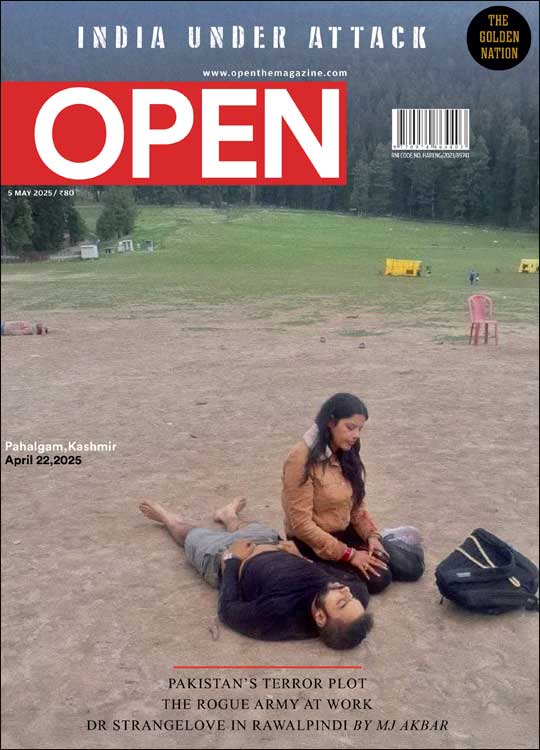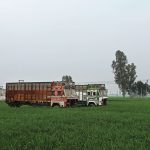Santali: Talking Time
Two tribal villages in Bengal revive the Santali language
 Nandini Nair
Nandini Nair
 Nandini Nair
Nandini Nair
 |
11 Jan, 2017
|
11 Jan, 2017
/wp-content/uploads/2017/01/Talkingtime1.jpg)
PADA MURMU IS the kind of teacher any young child would be fortunate to have. Her eyes dance, her hands talk and her laughter soars as she attempts to engage every four-year-old in front of her. Seated under the sky which serves as a roof, and on gunny sacks that double up as chairs, these children are learning the Bengali alphabet. While most of the dozen-odd kids repeat after her, a few lose focus and play with the mud, drawing patterns and dropping pebbles. But even a casual observer will notice that this is an engrossed classroom. The students read the Bengali alphabet cards held out by Pada and recite ditties that she has taught them. This might seem par for the course in many schools, but here in Ghosaldanga, it is exceptional. Located around 170 km from Kolkata, just beyond the Kopai River, this is a rare Santali school. While any rickshaw waala from Santiniketan will tell you facts and fables about the connection between the Kopai and the great Bengali poet Rabindranath Tagore, Bengali is an alien language for these Santali students. And for native Bengali speakers, Santali is terra incognita.
Close to six million people in India speak Santali (2001 Census). It is spoken in Bihar’s Bhagalpur and Munger districts; Jharkhand’s Manbhum and Hazaribagh districts; Odisha’s Balasore district; West Bengal’s Birbhum and Bankura districts; and in parts of Assam, Mizoram, and Tripura. It is one of the few languages that is not particular to a single state, as Santali and its dialects (Karmali, Kamari-Santali, Lohari-Santali, Manjhi and Paharia) can be heard across the Chota Nagpur plateau. Interestingly, no one script is used for Santali. The Latin script is used in Bangladesh; Oriya script is used in parts of Odisha; the Ol Chiki script is used in certain pockets; and the Bengali script is used in Bengal. Santalis represent more than half (51.8 per cent) of the total Scheduled Tribe population of West Bengal. In the state only 40 per cent of Santals are literate (57 per cent of men; and a mere 27 per cent of women). These dry facts illustrate that while Santali is spoken by millions of people across eastern parts of India, its speakers remain outside the realm of letters, highlighting the importance of teachers like Pada.
Pada holds out a card which has the Bengali letter ‘e’ on it. The word that these four-year-olds learn is ‘e’ for ‘eeple’ (Santali for star, importantly not ‘tara’ for star as in Bengali). As soon as the children see the card, they break into a Santali song which goes, “There are so many stars in the sky/So many grains on the grounds/With joy we will cut the grain/And with joy we will sing and dance.” When Pada pulls out the card with ‘aa’ on it, the students chant out ‘aa’ for ‘aangrob’ (shirt in Santali). With mirth and gusto they chant the Santali rhyme they’ve learnt for this: “Anil babu is wearing a new shirt/And playing the flute/He might be lazy/But when he plays the flute/the women dance their best.”
For the students at Rolf Schoembs Vidyashram (RSV, locally also called the Ashram School), this non-formal Santal day school can make the difference between dropping out and flourishing. If they were to attend the local government school or Sishu Siksha Kendra (SSK), they would have been rendered mute. They would not have been able to ask the teacher, ‘Can I get a drink of water?’, ‘Can I use the restroom?’, because they do not know a word of Bengali. The Ghosaldanga Adivasi Seva Sangha (GASS) that works with the tribal population of two Santal villages (namely Goshaldanga and Bishnubati) uses education as a tool to merge and stand out. GASS, along with the Bishnubati Adivasi Marshal Sangha, has been working in these two Santal villages for close to three decades. When they began, each village had only one student who had completed the madhyamik (secondary) examination. They were Boro Baski in Bishnubati village (who now runs the Ashram School) and Sona Murmu (the first student of the Ashram School and secretary of GASS). The efforts of Sona Murmu and Boro Baski have slowly changed the education system of these two villages, which have a combined population of less than 1,000 people.
The story of RSV is itself an example of serendipity and perseverance. In 1984, as a 10-year-old Sona Murmu bumped into a German professor named Martin Kämpchen who had cycled down from Santiniketan. They both struck up a friendship. Speaking perfect English, Sona Murmu says, “My mother worked in a Muslim military person’s house. That exposure gave her the idea to educate me. My father was a labourer. Every evening Martin and I would go collect the boys in my village and we’d study together. Many students had simply dropped out or never attended school because they did not know Bengali. We realised we needed Bengali and Santali. It was important for us to realise the importance of living in our own culture.”
By learning Bengali (the state language) through Santali (their mother tongue), the students of Ashram School carve a path to their future while preserving their past. Knowledge of Bengali will help them find employment, while the wisdom of Santali will keep them rooted. Boro Baski, who has translated Rabindranath Tagore’s Bengali play Raktakarabi into Santali and has composed several of the rhymes, says, “In Bengali schools, students learn only about Tagore and Gandhi. Not our own story. They are learning only how to become non-Santali. They learn that their future lies in the mainstream. In mainstream culture, there is no space to learn about their own cultures. But if they were to learn the Ol Chiki script, where will they go from here? That is why we teach them Bengali through Santali.”
Boro Baski, who studied at a missionary school and later at Visva-Bharati in Santiniketan, knows all too well the dangers of losing one’s language. While he was punished in school for speaking in Santali, today he is the most educated person in his village. At the Indian Language Festival Samanvay 2016, held in Delhi, he said, “For the Santalis, the survival of our language means the survival of our culture.”
In Bengali schools, students learn only about Tagore and Gandhi. Not our own story. They are learning only how to become non-Santali
The two-pronged approach ensures that students at Ashram School—whether it is Jagdish who lives 5 km away, or Kolpi and Robina whose homes are closer—become bilingual, and thus independent. Sculpture and painting are part of the curriculum, as are dance and music. Santal students learn about their own history such as the Santal rebellion of 1855 against the British and the zamindari system; and their own freedom fighters such as Sidhu and Kanhu Murmu. The students even learn the English alphabet through song. They are taught ‘a’ looks like a pretty girl, while ‘b’ is a ladle to pour oil and ‘c’ is an open mouth. The alphabet book for the 80-odd students is bilingual, with every Santali word written alongside its Bengali counterpart, dadu (grandfather) is explained in Santali as gadam baba, and naach (dance) can be found cheek- to-jowl with the Santali enech.
IN MODERN URBAN societies, where the movement of people is not unusual, being bilingual is taken for granted. But for Adivasi children who are first-generation learners, whose parents are daily wagers, subsistence farmers, agricultural workers, learning in their own language tells them, ‘I am important,’ ‘My culture matters.’
Pada, the 22-year-old teacher, and a former student of RSV, attests to that. Speaking fluent Bengali she says, “Everything I knew, poetry, music, games, it was all in Santali. This school gave me a sense of community and I hope my students get to feel the same.” As a teacher, she believes that by learning Bengali through Santali, these students are able to find moments of co-relation.
Kalidasi Mardi, another teacher at the school, who also studied from KG to Class IV at RSV, echoes Pada’s sentiments. She is the first person in her family to be educated; today, she is a graduate of Visva-Bharati University. Speaking in Bengali, she says, “When I first started school, accessing Bengali was the toughest part. By learning Bengali through Santali I was able to overcome that.” Toying with her cellphone, she adds, “The biggest problem is illiteracy. If there is one thing I want to see is that the future generations do not suffer like my parents did.”
Even while Pada acknowledges that it is essential that the Adivasi children learn the dominant language, she also asserts, “Bengali and Santali can’t really meet.” Why? With rehearsed ease, she explains, “When I teach my students, I try to stress that we need to remember that the central ideas about Santali culture is dance, music and poetry. There is no way Bengali dance and music can compare to Santali. We have a song for every situation. We feel money takes away from the enjoyment of life. But to earn a livelihood, people have to learn other languages.”
Pada’s answer, which panders to all the classical notions of ‘tribal’, can seem cookie-cutter and even cliché. But in this school and in these villages, one can trace the truth behind her sentiments. Bishnubati village, around 5 km from the school, is a place of delicate beauty. Walking through, it is easy to idealise, even exoticise, the settlement. The harvest has just been completed, the toil of the year lies piled in heaps. The paths are swept clean and no open drains can be seen. With the festival season around the corner, the huts are awash in a new coat of mud, and intricate painted flowers creep up the doorway. Even frescoes span a few of the houses in the main lane. Sanyasi Lohar, artist and teacher at RSV, rallied together a few of the villagers to create these panels of art that depict local festivals and scenes from daily life.
Here in Bishnubati, the conversations of Satyajit Ray’s last film Agantuk (The Guest) come to life. In the movie, the mysterious guest (played by Utpal Dutt) , claiming to be an anthropologist, says he has spent numerous years with the Adivasis of the country, be it Kols, Bhils, Nagas or Santals. In a heated exchange with a lawyer friend, the Guest says that living with tribals he has found that technology is not only a matter of science exploration, rather it is about hunting, weaving, farming and building a hut. When asked about the ‘taboos’ of tribal life, such as witchcraft and shamans, he says the Adivasi doctor with his knowledge of medicinal properties, saved his life. He retorts with defiance, “My biggest regret is that I am not a tribal.”
The debate about whether tribals should be kept separate or should be ‘assimilated’ and ‘mainstreamed’ dates back to the creation of the Indian state. At that time, Jawaharlal Nehru and the Government took the position that they should be allowed their isolation. But as GN Devy, author, professor, linguist and founder of Adivasi Academy at Tejgadh, Gujarat, said at a talk in 2013 titled ‘Why do the Adivasis want to Speak’, “Nobody asked the tribal does he or she want to be left alone, or assimilated.”
In early December, when Bengalis were just pulling out their monkey caps and digging into nolen gur, a seminar was held in Ghosaldanga village about the role of a community museum and its role in the education and development of Santals. The speakers at the event included Sushanta Dattagupta (former Vice-Chancellor of Visva-Bharati) and Kakali Chakraborty (Deputy Director, ASI). The conversations pivoted around questions of modernity and tradition, preservation and dynamism.
The Museum of Santal Culture in Bishnubati itself is a place of good intentions but hapless execution. It wears a new coat of white paint, but within its walls, the items (musical instruments, traps and nets, ornaments) lie listless and reveal no stories. Here one can see the dangers of ‘museumifying’ a culture; it moves from a pulsing living entity to a fossil behind glass. But the question arises: how is one to capture the essence of an oral culture, where memories have not been written down?
The answer is to be found back at the school. It is the end of the school day, the students pack their bags and head out to the world outside. Talking about her students and own experience at RSV, Kalidasi Mardi says, “The school has given me the ability to talk—that is the biggest thing.” The efforts of those like Boro Baski ensure that Santals are given a voice to tell their own stories.

/wp-content/uploads/2025/04/ToC-Cover-Pahalgam.jpg)













More Columns
Centre warns media against TRP-driven coverage that endangers troops Open
Stitched in Silence: India’s Secret in Every Luxury Closet Immpana Srri
Was Shakespeare an Errant Husband? Nandini Nair